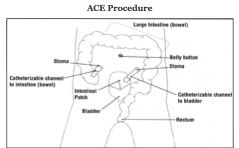What is an antegrade continence enema procedure?
The antegrade continence enema (ACE) procedure was developed to treat fecal incontinence (soiling) and severe constipation. The doctor uses a piece of bowel tissue to create a passageway between the large intestine and an opening in the lower abdomen or belly button.
A catheter is placed into the passageway once a day to give an enema. This flushes out the stool through the rectum and into the toilet. It usually takes 30-45 minutes to pass the stool and empty the entire colon. This prevents constipation and — because the colon is clean — soiling.
Who benefits from an ACE procedure?
At Gillette Children's, an ACE procedure is performed most often on patients who have spina bifida or spinal cord injuries, conditions that prevent good bladder and bowel control. People who have these conditions may experience severe constipation or fecal incontinence (soiling).
Success following an ACE procedure depends greatly on careful patient selection. Good candidates for the ACE procedure are physically capable and emotionally ready to handle a strict routine of intermittent enemas. Or, their caregivers are motivated to follow the routine.
What should I expect with an ACE procedure?
Before Surgery: You'll need to do a day or two of home bowel preparation to clean your bowel.
During Surgery: The surgery can last many hours if more than one procedure is done.
After Surgery: You’ll have an IV to give you medicine, fluids and nutrition. When bowel activity resumes, you’ll slowly advance from clear liquids to full liquids to soft foods.
There will be a dressing or covering over your incision. There will be a catheter in your new ACE site that will
remain capped until your doctor tells you to begin using it.
After Recovery: When you return to the clinic, about three weeks after surgery, your doctor and nurse will teach you how to use your new ACE. If you are completely healed, you’ll go home with a regular schedule for catheterizing your new ACE.

This information is for educational purposes only. It is not intended to replace the advice of your health care providers. If you have any questions, talk with your doctor or others on your health care team.
If you are a Gillette patient with urgent questions or concerns, please contact Telehealth Nursing at 651-229-3890.
 Home Page
Home Page
